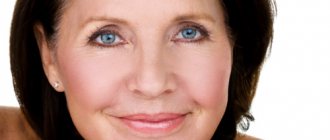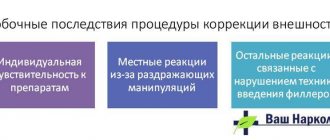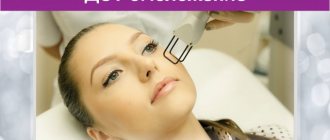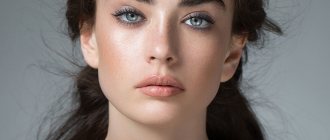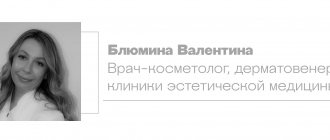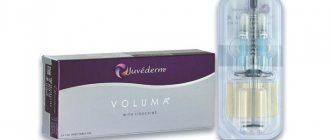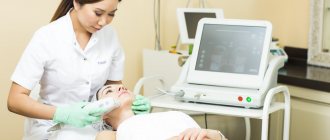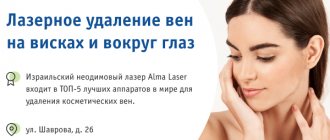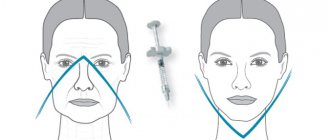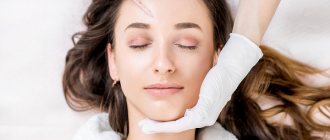Fractional photothermolysis, also called DOT therapy or DOT rejuvenation, is a laser skin rejuvenation procedure through negative stimulation of different layers of the dermis. Fractional laser “resurfacing,” despite its effectiveness, is a rather traumatic method of correcting surface defects, since it is based on the method of microscopic damage to the skin using heat shock. During the procedure, which can last up to 1 hour, more than 24.3% of the cells that make up the outer layer of the skin die, which stimulates increased regenerative and reparative ability of tissues and renewal of the epidermis. With the help of fractional dermal photothermolysis, you can not only cope with scars, scars, stretch marks and the effects of acne, but also improve the appearance of the skin, which cannot be achieved with classic “pulling” during surgical correction.
Fractional laser photothermolysis
The essence of fractional laser rejuvenation
One of the newest modern developments in the field of cosmetology is the technique of fractional laser rejuvenation. Currently, it is not without reason that it can be called the most popular of all laser therapy procedures.
During the session, a laser beam passed through a special fractional grid breaks up into a large number of microbeams. This method provides a targeted (fractional) effect on the skin without completely disrupting it.
Recommended articles on the topic:
- Ultrasonic facial peeling is a pleasant and beneficial procedure for your skin
- Redermalization of the skin: all the pros and cons
- Almond peeling for the face: features of the procedure
Many tiny treatment areas are formed in the dermis layer, where the development of renewed young skin tissue occurs very quickly. Cells located around the affected areas begin intensive division, filling the damaged areas. As a result, rejuvenating processes in the deep layers of the dermis are stimulated. Micro-rays, affecting the middle and upper layers of skin tissue, help eliminate pigmentation, wrinkles and scars.
Fractional laser rejuvenation of facial skin helps it gain firmness and elasticity. In addition, thanks to the procedure, pores are significantly reduced, the oval of the face becomes more toned, the shade and texture of the skin becomes smoother, and wrinkles and scars are significantly smoothed out.
Types of Fraxel laser
There are several varieties of Fraxel laser, each with its own specific features.
Fraxel Restore
It is the most common device. Its wavelength is 1,550 nm, and the penetration depth can be adjusted from 0.4 to 1.4 mm. Helps eliminate age spots, acne, sunburn, acne marks, and also fights skin photoaging.
Re Fine
This is an ebrium laser that has a wavelength of 1,440 nm. Of all the models presented, it is the most gentle, therefore it is used on delicate areas of the face and body. It is also advisable to use it for people with thin and sensitive skin.
This model can even be used to treat the mammary glands and eyelid skin. And the recovery period after its use is minimal.
Restore Dual
The model is more advanced, as it combines 2 lasers and has different wavelengths:
- ebrium – 1,550 nm;
- thulium – 1,927 nm.
This model is used to eliminate scars and scars, deep and fine wrinkles, remove pigmentation and remove post-acne.
Re Pair
Of all the models presented, it is the most aggressive. Therefore, they only treat the deep layers of the epidermis. This device can eliminate even deep wrinkles on the face and neck. It also works great on scars and blemishes.
Benefits of fractional laser rejuvenation
This technology has been used in the field of cosmetology for more than 10 years. It is effective, safe and has a number of advantages when compared with other rejuvenating and healing techniques:
- practically does not cause side effects;
- non-invasive, so there is no chance of client infection (including HIV);
- painless and quite comfortable;
- allowed from 16 years of age;
- hygienic, since the instruments do not come into contact with the skin;
- suitable for atonic skin types;
- it is possible to choose an individual treatment program;
- Suitable for clients with any degree of skin pigmentation;
- areas with defects are treated pointwise, so the possibility of damage to healthy tissue around is excluded;
- due to the fact that only 25% of the skin is injured, the recovery period after the procedure is short (face – seven days, body – 14 days);
- the effect becomes noticeable immediately after the first procedure;
- the result obtained lasts for several years;
- it is possible to treat delicate areas;
- in affected areas, elastin production is significantly accelerated.
Benefits or harms of laser
Advanced technology allows for uniform action on the desired areas of the skin. And thanks to the gentle effect and small diameter of the treated area (70 - 150 mn), scarring does not occur. Regeneration takes place in the shortest possible time and rarely takes more than a day.
The barrier function of the skin is not affected by radiation, so infection is completely excluded. The laser does not affect internal organs, acting exclusively on the skin.
Therefore, we can say that laser exposure brings significantly more benefits than harm.
Indications for the rejuvenation procedure
Fractional laser rejuvenation can be used for:
- general skin rejuvenation;
- skin lifting (face, neck, décolleté, hands);
- smoothing scars;
- skin smoothing;
- restoration of the oval contour of the face;
- wrinkle removal;
- elimination of pigment spots and melasma;
- removal of stretch marks (striae);
- eliminating the consequences of acne.
As a result of intense exposure to fractional laser, the skin may become hyperpigmented for a short period of time.
To get a good result, after the procedure it is necessary to treat the skin with sunscreen cosmetics with a protection level of at least SPF 50.
Fractional grinding can be compared with continuous grinding in terms of the resulting effect. Judging by the extensive foreign and domestic experience, this hardware technique is less traumatic and leads to an amazing rejuvenating and tightening effect.
Types of photothermolysis
The laser procedure has 2 types:
- Selective photothermolysis involves selective exposure of the surface layer of the problem area to a light source. It breaks down, resulting in the skin being freed from dead cells. And healthy ones begin to divide more actively, which leads to rejuvenation.
This more traumatic type of procedure is also called ablative photothermolysis. It is more suitable for eliminating problems associated with defects in the surface of the epidermis. Using a selective method, fractional photothermolysis of scars is carried out.
They also eliminate unevenness, hyperpigmentation, keratosis, poor color, and mild age-related changes.
- Non-ablative photothermolysis acts selectively on deeper areas of the skin. The microholes that radiation makes in the dermis serve as a stimulus for the formation of new cells in the collagen and elastin layers. This type of procedure is more suitable for rejuvenating the face, eyelids, neck and other areas, eliminating acne marks and stretch marks. It does not affect the epidermis, so rehabilitation is faster and causes less trouble.
Fractional rejuvenation for the treatment of scars and stretch marks
This rejuvenation method is especially effective in treating scar tissue. Fractional laser beams have the ability to crush roughened scar tissue, after which it acquires elasticity, softness, and the tension of the surrounding healthy tissue decreases.
Fractional photothermolysis helps reduce the area of scars, making them elastic, unnoticeable, and as close as possible in appearance to healthy skin.
Fractional rejuvenation is indicated for the treatment of stretch marks. Sadly, stretch marks cannot be completely eliminated, you can only make them more invisible.
The effect of fractional treatment is:
- reducing the area of stretch marks;
- reducing tissue fiber breaks;
- aligning the shade of stretch marks with the tone of healthy skin;
- increasing the elasticity and firmness of the skin tissue around and relieving tension.
Contraindications for such rejuvenation
Fractional rejuvenation, like any cosmetic procedure, is not suitable for everyone. Therefore, in order to avoid negative consequences, before the session it is necessary to carefully study all contraindications.
Fractional photothermolysis is not recommended:
- during pregnancy and during breastfeeding, since any changes that occur in the body of a pregnant or lactating woman affect the baby - you should not risk the child’s health, it is better to postpone the procedure;
- in case of inflammation (or redness) in the treated area, the cosmetologist will refuse to carry out fractional laser photothermolysis in the cheek area if they are covered with an allergic rash (the laser beam can damage the skin up to deep scars);
- for chemical peeling - if you have cleansed your face, you need to allow the layers of the epidermis to strengthen for two weeks (minimum) and prepare for exposure to the laser beam;
- in the presence of oncological diseases, since spontaneous complications may arise as a result of laser exposure;
- with diagnosed diabetes mellitus;
- in the presence of viral and bacterial infections - in order to avoid the invasion of foreign elements into the cell structure during fractional rejuvenation, it is first necessary to recover completely.
Preparation and progress of the procedure
To avoid disastrous consequences in the form of complications after a cosmetic procedure, it is necessary to carefully prepare for it.
First, you need to consult with a cosmetologist and get an assessment of the condition of the skin on your face. The specialist will determine a list of contraindications and give the necessary recommendations.
Before the procedure, it is not advisable to visit the bathhouse, sauna, or solarium for 3–4 weeks. In addition, sunbathing in the open sun is prohibited. Before going outside, you need to apply sunscreen to your face.
It is very important to stop taking certain medications, particularly antibiotics and blood thinners. In addition, doctors recommend taking antiherpetic medications.
No later than two weeks in advance, it is not recommended to perform manipulations that injure the skin tissue.
We recommend
Laser hair removal of the abdomen: contraindications, features of the procedure and care Read more
Fractional laser rejuvenation of the eyes and other areas takes place in several stages. First, the cosmetologist must prepare the skin areas for the procedures. To do this, it removes the remnants of decorative cosmetics from the skin, as well as dirt, dust, and sweat. Then the surface is treated with an antiseptic.
The next step is to apply an anesthetic cream, which is left on the skin for about an hour.
After anesthesia, contact gel is evenly applied to the face so that the sensor glides smoothly and evenly over the surface of the skin.
The tip is then used to process the skin tissue in straight lines in several directions. The device is equipped with nozzles of different sizes. Typically, 2 cm² of skin is treated in one pass.
At the end of the procedure, the specialist should remove the remaining contact gel and apply a soothing cream.
After care
After manipulation, the skin looks red and slightly swollen. There is slight pain and burning. Signs persist for up to 2.5 days. To ensure that they disappear quickly and no more serious problems arise, the patient should:
- Do not wet the laser treated area for 2 days,
- carry out hygiene with an antiseptic, but not alcohol,
- Apply Bepanten or Panthenol to the skin 3 times a day,
- protect it from any mechanical and chemical influence,
- do not exfoliate the skin, let it free itself from the dry crust on the surface,
- Do not use decorative cosmetics for 3, 5 days,
- avoid any overheating for at least 2 weeks, that is, do not go to the bathhouse, do not lie in a hot bath,
- postpone sports activities for the same period,
- stop drinking alcohol and smoking,
- go outside after using sunscreen,
- Don't sunbathe for a month.
Number of sessions
After fractional laser rejuvenation of the eyelids and other problem areas, rehabilitation of 3–7 days is required. The duration of the rehabilitation period will depend on the patient's lifestyle. For example, bad habits, poor nutrition, excessive physical activity, stress and disturbed sleep can significantly slow down skin regeneration after the procedure.
During the first three days after the session, redness and slight swelling may appear on the skin. To reduce the level of discomfort, you can take painkillers and use skin cooling products.
It is considered normal if during the first week the skin feels tight and peels in some places. Side effects include a bronze tint to the face, which disappears after 14 days.
A lasting result can be achieved by performing two to five procedures. A cosmetologist can tell you exactly how many sessions are needed, depending on each individual case and the client’s initial data.
The interval between sessions should be at least 3-4 weeks. Fractional laser rejuvenation slows down aging: wrinkles decrease or disappear completely, turgor increases, pores narrow, and complexion evens out. This method effectively removes pigmentation, post-acne, stretch marks and scars.
Advantages of the Fraxel laser
The main advantages of such laser treatment include:
- Possibility of affecting different areas of the skin (even the mammary glands and eyelid area).
- Possibility of targeted impact on the skin, affecting only those areas that should be treated with laser.
- The ability to renew and heal the skin at the cellular level, activating the internal resources of the body.
Possible side effects
Complications after fractional laser rejuvenation procedures are extremely rare. Most often, negative consequences are observed due to the unprofessional actions of a cosmetologist who neglects the processing instructions. Sometimes side effects occur due to the client's failure to follow skin care recommendations.
Most likely complications:
- severe hyperemia of the skin, which goes away on its own after three days;
- swelling;
- dark skin tone;
- excessive dryness and flaking of the skin;
- burns;
- scars and cicatrices;
- white or yellow milia raised above the surface (dense nodules that form under the skin);
- inflammatory processes in damaged areas;
- the phenomenon of hyperpigmentation (may appear as a result of exposure to sunlight).
Complications after fractional laser rejuvenation will not appear if you prepare well before the procedure, choose a reliable clinic and an experienced professional.
Frequently asked questions about fractional laser rejuvenation
Minimum age allowed for laser facial rejuvenation
There are practically no restrictions. The procedures can be performed as early as 17 years of age to get rid of acne scars.
For women over 40 who want to maintain youth and attractiveness, the technique is especially useful, since laser beams provoke the production of their own collagen by skin cells.
The recovery period after fractional laser rejuvenation is usually 7–14 days. The duration of rehabilitation depends on the complexity of the problem and the type of laser treatment.
When can I start working?
This depends on what type of laser treatment was used, on the area of problem areas, and on the experience and skills of the cosmetologist. The recovery period, based on the method and complexity of the defects, ranges from two days to three weeks. It happens that the patient can start working just a day after the session.
How long does it take to see results?
It takes about six months for the skin to be completely renewed and the effect to become noticeable. The result lasts for about five years.
Fractional laser facial skin rejuvenation is a highly effective cosmetic procedure. It has many advantages compared to similar anti-aging techniques. But you need to know that this procedure is not suitable for everyone and has contraindications. Therefore, you must first consult with a specialist. And to reduce the risk of complications, you should choose only reliable and trusted clinics.
Why clients choose Veronika Herba Beauty and Health Center:
- This is a beauty center where you can take care of yourself at a reasonable cost, while your face and/or body will be treated not by an ordinary cosmetologist, but by one of the best cosmetologists in Moscow. This is a completely different, higher level of service!
- You can receive qualified help at any time convenient for you. The beauty center is open from 9:00 to 21:00, seven days a week. The main thing is to agree with your doctor in advance on the date and time of your appointment.
Sign up for a consultation with a specialist by phone +7 (495) 085-15-13
, and you will see for yourself!
